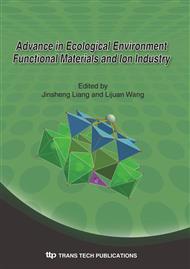p.135
p.141
p.145
p.151
p.155
p.161
p.165
p.171
p.177
Preparation of Expanding Vermiculite by Chemical and Microwave Methods
Abstract:
Based on the characters of expanding and layer adsorbing of vermiculite,industrial vermiculite samples from Weili Mine of Xinjiang Province were expanded by both chemical and microwave chemical methods. The influences to the exfoliation ratio of different parameters such as concentration of hydrogen peroxide, power of the microwave, heating time, ratio of solid-liquid, immersion time were discussed. And the expanded mechanism of vermiculite was also analyzed. The results indicate that the expanded times increase with the increasing of concentration of hydrogen peroxide, and the best expanding point appears when the concentration of hydrogen peroxide is 30%. The solid-liquid ratio of vermiculite and hydrogen peroxide has little effect on the expanding of vermiculite. The vermiculite samples could be expanded 8.5 times by heated 2 min under 800W microwave power after immersion for 12 h when the concentration of hydrogen peroxide is 30%. As a result, the vermiculite could be expanded because of the oxygen pressure produced by the decomposition of hydrogen peroxide into the vermiculite interlayer. When using the microwave chemical method, the pressure of both oxygen and interlayer water lead to the increases of the expanded times. And exfoliation vermiculite plays an important part in energy-saving and environmental treatment.
Info:
Periodical:
Pages:
155-160
Citation:
Online since:
January 2010
Authors:
Price:
Сopyright:
© 2010 Trans Tech Publications Ltd. All Rights Reserved
Share:
Citation:


